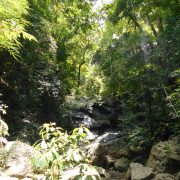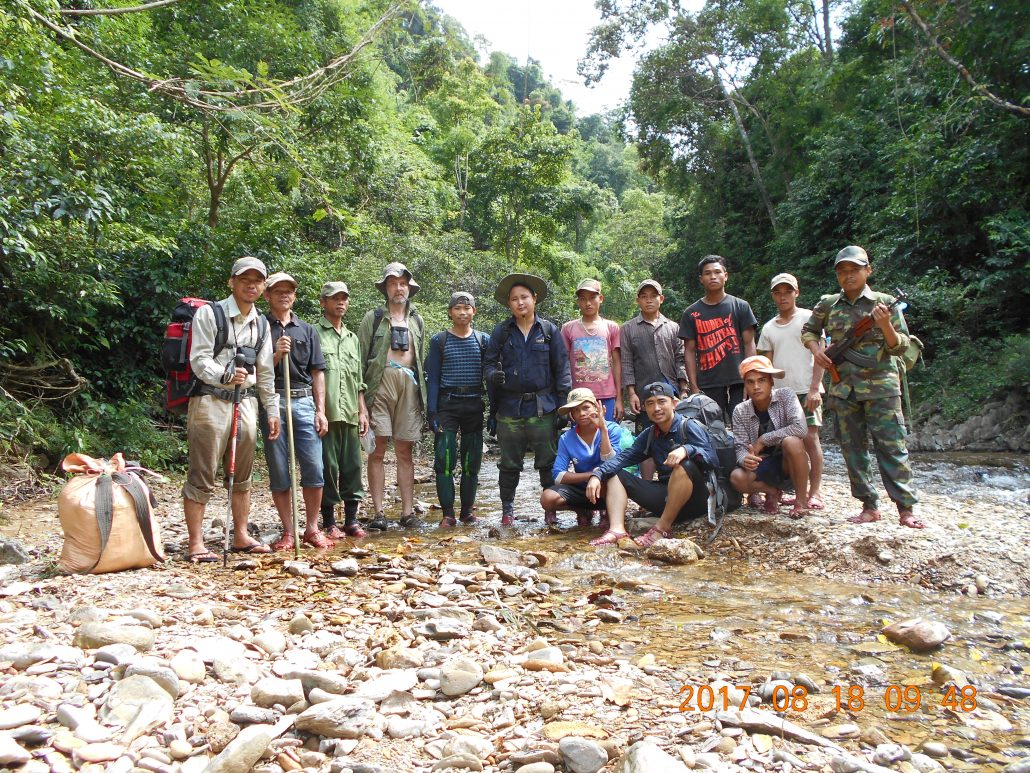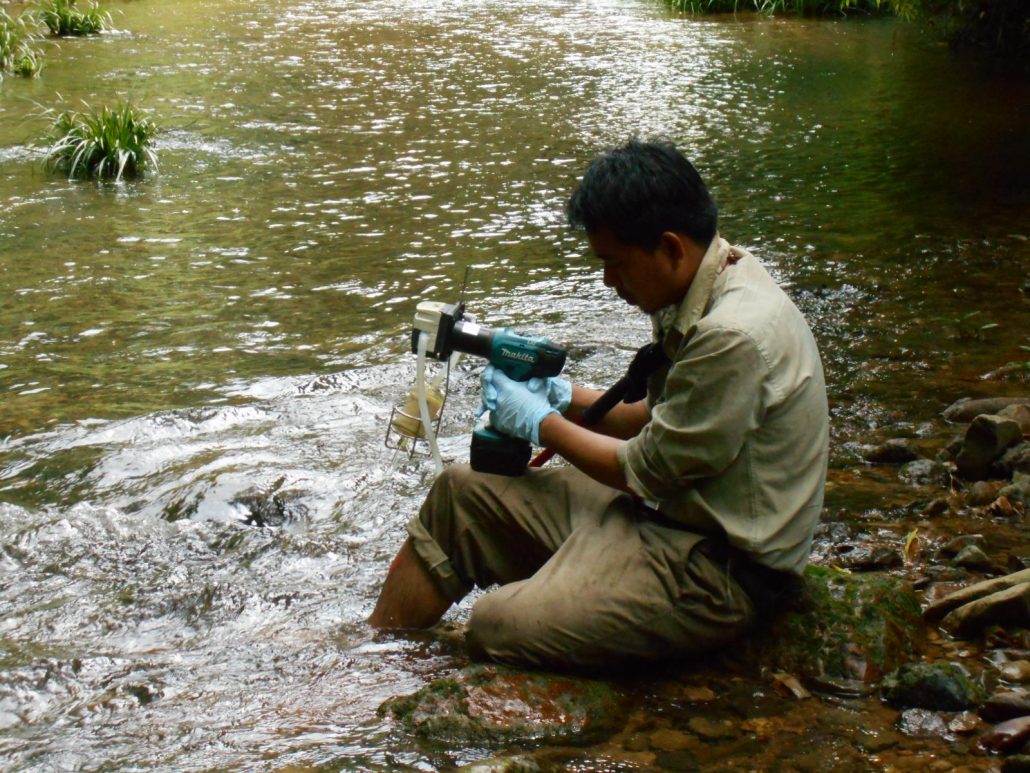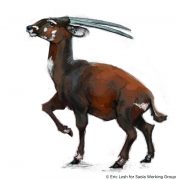SWG Survey of Khoun Xe Nong Ma Reveals Surprisingly Intact Saola Habitat
It was bedtime in late September when SWG member Chanthasone Phommachanh (better known as Olay) turned from his notebook to see what was rustling near his jungle hammock. It had been a long day deep in the forests of Khoun Xe Nong Ma, a provincial-level protected area in Laos against the border of Vietnam where Phommachanh and an expedition team were collecting information about the area–species observed, signs of poaching, and data on the habitat.
This evening, the wildlife came to Phommachanh. He shined his flashlight at the noise and there, just 1.5 meters away, stood an Annamite Striped Rabbit. “I could see the stripes, the black and yellow stripes like a tiger, and I knew it was an Annamite Striped Rabbit for sure,” Phommachanh says with a certain excitement reserved for wildlife lovers. “It was amazing. I watched it for 20 seconds and then when he saw me, he took off in one jump, one very long jump.”
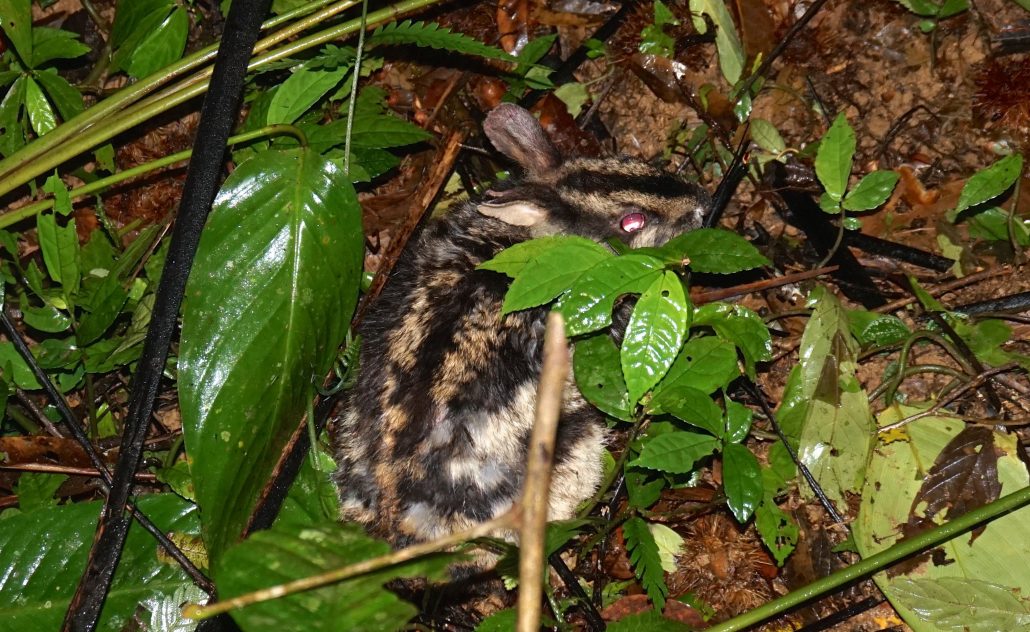
The Annamite Striped Rabbit is a rare Annamite endemic discovered shortly after the Saola. (Photo courtesy of Andrew Tilker)
This encounter gives Phommachanh the distinction of being among the only biologists to ever see an Annamite Striped Rabbit in the wild. But the moment also underscores the unexpected findings of an expedition that, over the course of about a month, revealed a relatively healthy community of biodiversity and a surprisingly intact core of habitat. And if an animal as elusive and rare as the Annamite Striped Rabbit can be found here, then maybe, just maybe, the Saola can, too.
Hope Unexpected
SWG member Rob Timmins is no stranger to the rapid and pervasive waves of poaching devastating populations of wildlife across the Annamite Mountains. He has been doing these kinds of expeditions in the area for more than 20 years, and as the years have gone by, he has learned to expect surveys to reveal fewer animals and more snares.
“There’s basically no forest in Indochina that has escaped at least some level of exploitation,” Timmins says. “There’s no area that you could find today that still has the most valuable species in any abundance. In general these days, I go into an area with considerably lowered expectations and in most of the areas I’ve surveyed in the last 10 years, those expectations have actually turned out to be even more optimistic than what we find in reality.”
Phommachanh and Timmins’ expedition to Khoun Xe Nong Ma, however, surprised them, defying their generally lowered expectations. Timmins says he’s been lucky to see primates once a week on past expeditions to other habitat in the Annamites, but reports seeing primates daily on this trip. Timmins also says the team came across signs of ungulates more frequently than on expeditions anywhere else in recent years. And in addition to the Annamite Striped Rabbit—an Annamites endemic discovered by none other than Rob Timmins shortly after the discovery of the Saola—Phommachanh reports seeing muntjacs, serows, Sambar Deer, gibbons and doucs, and hearing the rare Crested Argus call.
The team was also surprised to find very little evidence of hunting, especially snaring, in the forests. They determined that an area of core habitat about 200 square kilometers in size hasn’t yet experienced the kind of industrial-level snaring that is pushing Annamites endemics–rare, near-mythical species–to the brink of extinction, including the Saola. Timmins calls this discovery in today’s age of poaching unprecedented.
“I went in with an expectation that we would find snares pretty much throughout, and that maybe, if we were lucky, we’d find some sort of areas where the snaring had only been going on for a few years,” Timmins says. “Khoun Xe Nong Ma has experienced some of these waves of poaching, but it hasn’t experienced this kind of newest wave of industrial-level snaring. I was really surprised to find as large an area as we did without snares. It was really fantastic.”
A Future for Khoun Xe Nong Ma
While still in the field, Phommachanh and Timmins sent message by satellite out to the Lao government and its partner, Integrated Conservation of Biodiversity and Forests (ICBF), and the Saola Working Group to alert them of the snares the team did find. ICBF had already sent a team to clear snares from a nearby area where Phommachanh had done a preliminary survey in July, and is in the process now of carrying out a snare-removal mission based on the most recent survey. In the next step, ICBF, which helped to fund the Khoun Xe Nong Ma expedition, will be adding patrolling stations and developing and organizing permanent patrol teams for the forest with the aim of preventing future threats. And the government plans to upgrade Khoun Xe Nong Ma from a provincial-level protected area to a national-level protected area sometime in the next year.
“It’s really encouraging that this project is ready to act, and it’s ready to act quickly,” Timmins says. “Unless there’s good protection for the area, just like everywhere else these species are going to disappear and it’s going to happen quickly. It is still possible at this point that we can actually do something.”
In the meantime, Phommachanh and Timmins are eagerly awaiting the retrieval of photos from the more than 100 camera traps they set throughout the area. Phommachanh will be collecting data from the cameras’ SD cards in mid-November, and, as part of the urgent next phase of the survey, adding another 150 camera throughout the 200 square kilometers of relatively pristine habitat. They expect photos of Large-antlered Muntjacs, Owston’s Civets, Hog Badgers, Large Indian Civets, Crested Argus, macaques and maybe even the rare Edwards’s Pheasant.
“It would be very nice if there were Saola on there,” Timmins says, “but I won’t be disappointed if it isn’t. We need more of a focused effort to increase the odds of detecting them. But the SWG will keep this process going until we do detect Saola in the area.”
For Phommachanh, this expedition meant hope.
“Seeing animals in the wild in the thick forest of Laos is very difficult,” Phommachanh says. “Yet I saw so many species–muntjac, serow, Sambar, doucs and others. I even saw the Annamite Striped Rabbit. It gives me great hope that the Saola is here, too.”
Help support this crowdsourcing campaign to raise $41,000 for new cameras by Dec. 16 in the next vital step of this survey. Thanks to SWG supporter Kristine Karnos for making the campaign happen.
(Top photo: Khoun Xe Nong Ma habitat, photo by Chanthasone Phommachanh)

